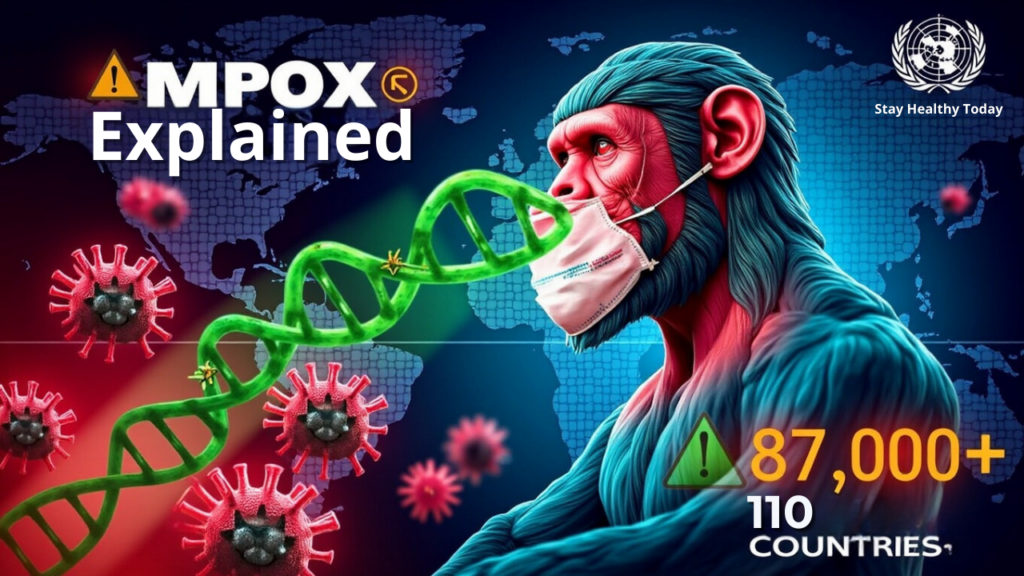Questions and Answers on Mpox
Mpox, a zoonotic disease caused by the monkeypox virus, continues to draw global attention due to its significant public health impact. According to recent data from the World Health Organization, over 87,000 cases have been reported across 110 countries since the start of the 2022 outbreak, emphasizing the urgent need for awareness and preventive action. Understanding the disease, its risks, and preventive measures is crucial for individuals and communities worldwide. This article answers common questions about mpox, providing accurate, research-based information to raise awareness and promote protection.

What is Mpox?
Mpox is a viral infection caused by the monkeypox virus, a member of the Orthopoxvirus genus. It was first identified in 1958 in monkeys used for research, hence the name. However, mpox primarily spreads through direct contact with infected animals, humans, or contaminated materials. Recent studies, including findings published in the journal “Emerging Infectious Diseases,” suggest that transmission patterns are evolving, with certain human-to-human interactions, such as prolonged close contact, now playing a more prominent role in the spread of the disease. The disease is characterized by symptoms such as fever, rash, and swollen lymph nodes, which can vary in severity.
How Does Mpox Spread?
The transmission of mpox occurs through several routes. Direct contact with bodily fluids, respiratory droplets, or skin lesions of an infected person is the most common way it spreads among humans. Additionally, handling infected animals or consuming undercooked meat from these animals can lead to infection. Understanding these transmission pathways is essential for effective prevention.
Who Is at Risk of Mpox?
Certain groups are more vulnerable to mpox, including healthcare workers, individuals in close contact with infected people, and those living in endemic regions. Additionally, individuals with compromised immune systems may experience more severe symptoms. Staying informed about risk factors can help mitigate potential outbreaks.
What Are the Symptoms of Mpox?
Mpox symptoms typically appear within 5 to 21 days after exposure. Early signs include fever, headache, muscle aches, and exhaustion. Within a few days, a distinctive rash develops, often starting on the face and spreading to other parts of the body. The rash progresses through various stages, eventually forming scabs that fall off. While most cases are mild, severe cases can occur, particularly in vulnerable populations.
How Is Mpox Diagnosed and Treated?
Diagnosis of mpox involves laboratory testing of samples from skin lesions or bodily fluids. Healthcare professionals rely on advanced diagnostic techniques, including polymerase chain reaction (PCR) tests, to confirm the presence of the monkeypox virus. Recent updates from the Centers for Disease Control and Prevention (CDC) highlight improvements in testing protocols, ensuring more accurate and rapid detection of the virus in suspected cases. Currently, there is no specific treatment for mpox. However, supportive care—including hydration, pain relief, and treatment of secondary infections—plays a crucial role in recovery. Recent studies, including findings published in 2023 by the “Journal of Infectious Diseases,” have confirmed that smallpox vaccines are effective in preventing mpox. These studies highlight not only the vaccine’s protective effects but also its potential to limit outbreak severity when administered promptly after exposure.
What Steps Can Be Taken to Prevent Mpox?
Preventing mpox requires a combination of personal and community-level measures. These include avoiding contact with infected individuals or animals, practicing good hygiene, and cooking meat thoroughly. In healthcare settings, using personal protective equipment (PPE) and following infection control protocols are essential. Vaccination campaigns targeting at-risk populations can further reduce the spread.
Practical Tips for Staying Safe
To protect yourself and others from mpox, stay informed about outbreaks in your area. Avoid close contact with individuals showing symptoms, and wash your hands frequently with soap and water. If you suspect exposure, seek medical advice promptly to reduce the risk of complications. Community efforts, such as educating the public about preventive measures, are also vital in controlling the disease.

Conclusion
Mpox is a public health challenge that requires vigilance and proactive measures. By understanding the disease and adopting preventive practices, individuals can significantly reduce their risk. Staying informed about scientific advancements and supporting community health efforts will ensure better preparedness for future outbreaks. Together, we can create a healthier, more resilient global community.
Stay Healthy Today: Symptoms and Transmission of Mpox

